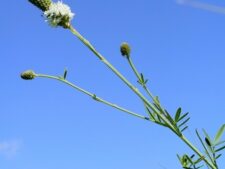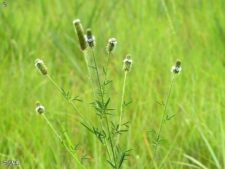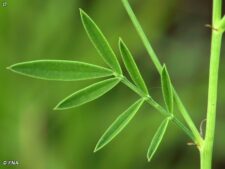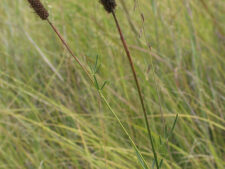
This native perennial has one to several stems 1-3 feet tall (C) arising from a taproot up to 6 feet deep. Delicate alternate leaves are divided into 5-9 leaflets up to 1 1/2 inches long and 1/4 inch wide (D). Many small, white flowers form a dense spike around a green cylindrical 1-2 inch long flower head (A,B,C). Flowering begins as a small ring at the base and often elongates as it proceeds to the tip (A). The small 1/16th inch black seeds persist on the head long after flowering (E).
Dry to moist prairie sites. At Neale Woods it is uncommon in several of the prairie restorations. It was planted in the floodplain garden opposite the parking lot at Fontenelle Forest, but has not been seen there since the flood of 2012. Flowering occurs mainly in June and July although occasional flowering plants may be seen as early as May and as late as September.
White flowers differentiate this plant from Purple Prairie Clover (Dalea purpurea). White Prairie Clover stems also have fewer leaves and broader leaflets, characteristics which may be useful when plants are not flowering.
This plant is palatable to livestock and decreases rapidly when overgrazed.
Gilmore indicates the Pawnee name translates as “broom weed,” a reference to the use of the stems to make brooms for sweeping the lodge floor.
The content of NatureSearch is provided by dedicated volunteer Naturalists of Fontenelle Forest who strive to provide the most accurate information available. Contributors of the images retain their copyrights. The point of contact for this page is: Neal Ratzlaff.

 Identification
Identification


